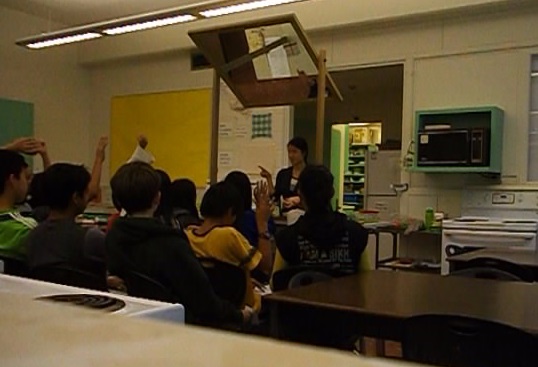Practicum Observations
During my short term practicum, I observed the ways teachers managed their classrooms. I then categorized their techniques into a few groupings. Teachers connected with students, used preventative discipline, asked questions to students, used inductive reasoning, commanded obedience, expressed their own displeasure, expressed their observations, and warned students. The teachers also sometimes used short nonverbal as well as verbal cues.
- Connecting with students:
- room decked out with teacher’s own interests (outside of education) and teacher references pop culture – when asked about it, the teacher said that kids want to connect with teachers somehow and that is one way of doing it
- affirmed students who did something well and used it as a model: for example, teachers loudly said they liked how a certain group organized the seating arrangements to facilitate better discussion
- praised students and said that their ideas were great
- acknowledged student’s progress: for example, a student was close to being on time, and the teacher acknowledged that it was an improvement compared to previous days and encouraged the student by saying that maybe next time, he/she will be on time
- affirm/praise students on their accomplishments: for example, acknowledged that the student was the first to complete, and praised him/her
- ask students why they were absent – shows concern for them; reaction was not one of condemnation but listened with concern and genuinely seemed to want to know
- ask about their life: ask how the student’s dentist appointment was, or how the sports game was (memory)
- Preventative:
- Separating noisy students into different groups
- 1 min timer on the oven
- Roam, checking to make sure students are on task
- Bags at the front of the room and hands washed
- Put out hand and count down
- Time updates
- Dividers up for tests/quizzes
- Student check-outs: sign on the board
- Students bring books every day – sometimes they have a pop open-book test
- Asking questions:
- to gauge whether delivered information/direction was clear
- to ask why students were late
- to find out, when students were talking, if there was a problem
- to question why students were talking
- to discover if students had a question or were confused about something
- to guide the students to the correct behaviour (anticipatory fill in the blank type of question)
- Inductive:
- telling students that if they listen well the first time, there will be less time spent listening and more time doing (explaining the benefits of listening)
- Commands to:
- stop talking
- speak English and not to speak first language in class
- put away cell phone
- respect other people’s space
- Own displeasure:
- saying that something is not working for the teacher
- expressing worry that the students are not listening
- Observations:
- expressing an observation that a student does not have their book open when the students are expected to
- expressing an observation that the students are not listening
- Warning:
- telling students that if they continue being quiet, they will need to get back to their seats
- telling students that if they ask about marks again, they will be punished (said in a joking way with a smile)
- Short:
- name
- “Hey!”
- shushing
- clap
